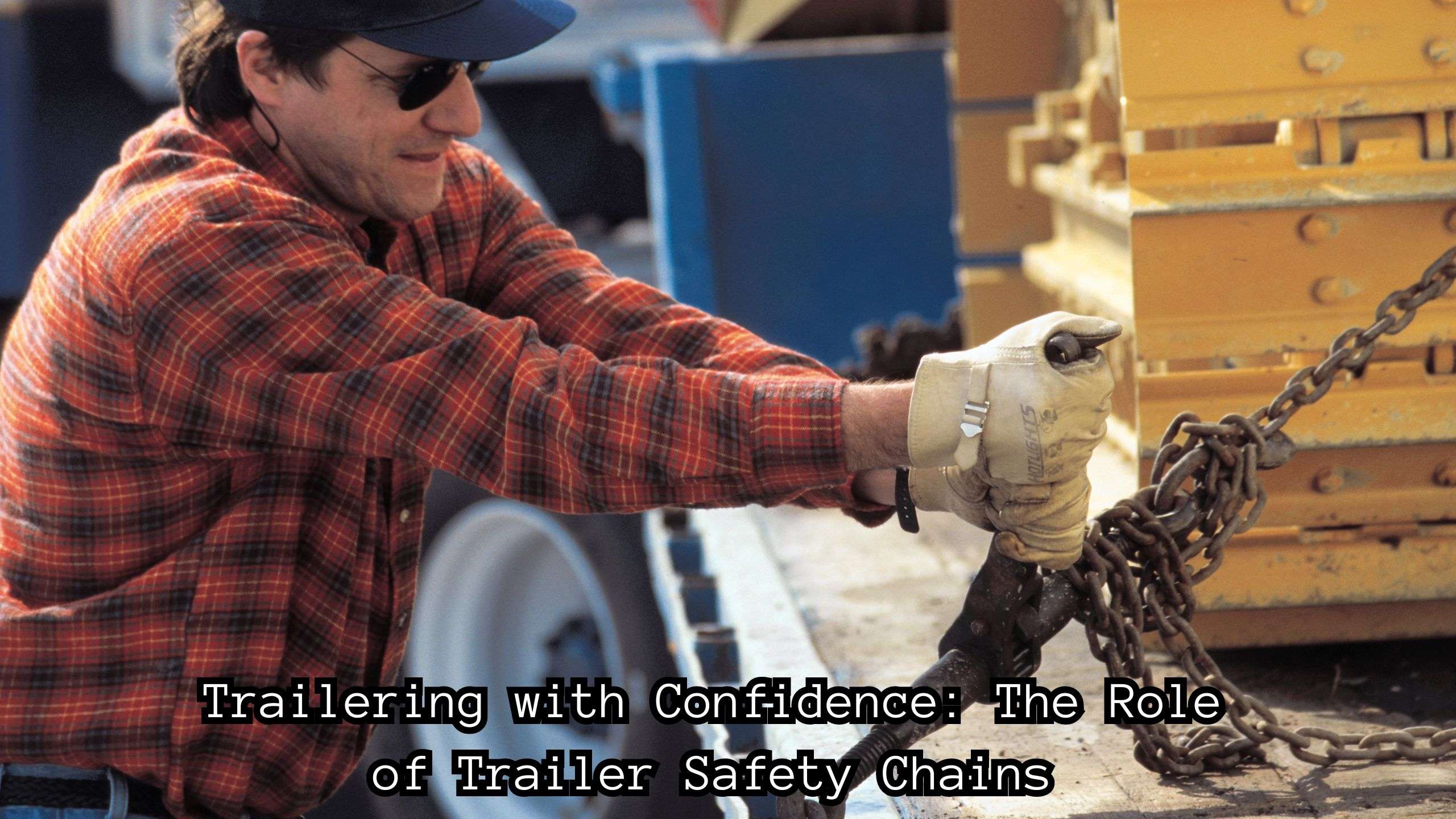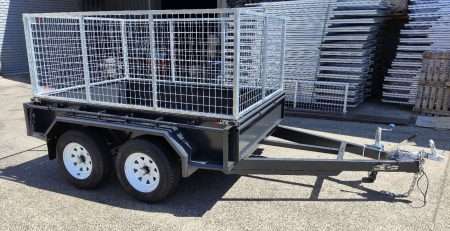
Trailering with Confidence: The Role of Trailer Safety Chains
Understanding Trailer Safety Chains
When it comes to towing a trailer, safety is paramount. Among the numerous elements that contribute to the safe towing of a trailer, safety chains play a crucial role.
Importance of Safety Chains
Safety chains are essential components of trailer towing systems. They provide an extra layer of security by connecting the towed trailer to the towing vehicle. This connection is a fail-safe mechanism designed to prevent complete separation in the event of a hitch failure (bulletproof hitches).
In simpler terms, if the main connection between your trailer and towing vehicle fails, these chains ensure that your trailer doesn’t completely detach and cause a hazardous situation on the road. They help maintain control in such circumstances, which is why they are a critical part of towing safety.
While safety chains are a necessary component, they are not the only ones. A comprehensive towing system includes a variety of elements, such as heavy-duty trailer hitches, trailer brake controllers, trailer hitch locks, and trailer lights and wiring, among others.
Legal Requirements for Safety Chains
Apart from being an essential safety measure, the use of safety chains is also a legal requirement in most states and provinces. Safety chains are required for all trailers weighing over 3,000 pounds.
These laws and regulations help ensure that trailers are safely secured to their towing vehicles, reducing the risk of accidents caused by trailer detachment. Failure to comply with these regulations can result in penalties, including fines and possible towing restrictions.
Before towing a trailer, always make sure to check the local laws and regulations regarding safety chains. Following these guidelines will not only keep you legally compliant but also significantly enhance the safety of your towing operations.
Installing safety chains correctly
The correct installation of trailer safety chains is a critical aspect of trailer safety. Proper positioning and attachment of the chains can prevent accidents and ensure a smooth towing experience.
Positioning of Safety Chains
The first step in installing safety chains is positioning them correctly. Safety chains should be crossed under the trailer’s tongue to form a cradle shape. This formation helps to catch the tongue and prevent it from hitting the ground if the hitch fails. This positioning tip is backed by multiple experts in the field, including bulletproof hitches, carry-on trailers, and laclede chains.
The idea behind creating a cradle or basket is to provide a safety nett for the trailer’s tongue. In the unfortunate event of a complete hitch failure, the tongue of the trailer will fall into this cradle instead of crashing onto the road. This simple yet effective positioning can potentially prevent serious accidents and costly damage to your trailer.
Attaching safety chains properly
Once the chains are correctly positioned, the next step is to attach them properly. The chains should be securely fastened to the hitch or the vehicle frame, depending on your specific setup. It’s crucial to ensure that the chains are tight enough to perform their job but also loose enough to allow for full movement of the trailer.
When attaching the chains, make sure they are not dragging on the ground, as this can cause premature wear and potential failure. The chains should be of equal length to maintain balance, but short enough to keep the tongue off the road.
Remember, the main purpose of trailer safety chains is to provide a backup connection between the trailer and the towing vehicle. So, proper attachment is just as crucial as correct positioning.
In our next sections, we will discuss how to choose the right safety chains for your trailer and how to maintain them to ensure they perform effectively and last a long time. We will also delve into other important trailer parts such as trailer hitch locks, trailer brake controllers, and trailer lights and wiring, among others.
Choosing the Right Safety Chains
When it comes to securing your trailer, choosing the right safety chains is critical. This involves two main considerations: the weight capacity of the chains and the length of the chains. Both of these factors significantly contribute to the safety and performance of your trailer setup.
Weight Capacity of Safety Chains
The weight capacity of safety chains is a crucial factor to consider. Safety chains should have a minimum breaking strength of 5,000 pounds, as per Laclede Chain. This strength is necessary to prevent trailers from becoming detached from the towing vehicle in the event of a hitch failure, especially for trailers weighing over 3,000 pounds.
Also, it’s recommended that the chains be attached to the trailer with a quick link or a horseshoe-shaped clevis for efficient performance. The weight capacity of the chains should match or exceed the gross trailer weight (GTW) of your trailer. GTW is the weight of the trailer fully loaded in its actual towing condition.
| Trailer Weight | Minimum Breaking Strength |
|---|---|
| Under 3,000 lbs | Not required |
| 3,000 lbs. and above | 5,000 lbs |
Length Considerations for Safety Chains
The length of the safety chains is equally important. Safety chains should be adjusted to have enough slack to allow for turning and manoeuvring without binding. However, they should not have so much slack that they can drag on the ground or become entangled with other objects (Laclede Chain).
Two safety chains are required for a trailer and must be attached to their own chain retainers. The chains should be crossed beneath the trailer tongue to catch the tongue in case it drops. The length of the chains should allow you to fully turn the trailer without them becoming taut.
When choosing the best safety chains for your trailer, remember to consider both their weight capacity and length. These factors are crucial for maintaining control and safety while towing your trailer. For further information on trailer safety and equipment, check out our articles on trailer hitch locks, trailer brake controllers, and heavy-duty trailer hitches.
Maintaining your safety chains
Taking care of your trailer involves more than just keeping it clean and ensuring it’s well-lubricated. One of the key elements that requires regular attention is the trailer safety chain.
Regular Inspection of Safety Chains
At the heart of maintaining your safety chains is regular inspection. It’s important to check your chains for any signs of wear, damage, or rust. Safety chains should not drag on the ground but instead be adjusted to have enough slack to allow for turning and manoeuvring without binding. However, there should not be so much slack that the chains can become caught on the ground or other objects (Laclede Chain).
Whenever you prepare for a trip, take a few moments to inspect your safety chains. This includes checking the chains themselves as well as the quick link or horseshoe-shaped clevis used to attach the chains to the trailer. These components should have a minimum breaking strength of 5,000 pounds to ensure they can withstand the weight of the trailer should the hitch fail.
When to replace safety chains
Over time, safety chains can become worn or damaged, and when this happens, it’s crucial to replace them. If you notice any signs of wear or damage during your regular inspections, it’s time to invest in new safety chains. This is necessary to prevent trailers from becoming detached from the towing vehicle in the event of a hitch failure (ladle chain).
In addition to physical damage, be sure to replace your safety chains if they show signs of rust. While a little surface rust may not be a cause for concern, deep rust can weaken the chains and put your trailer at risk.
For other trailer maintenance needs, be sure to check our articles on trailer hitch locks, trailer brake controllers, and trailer lights and wiring.
Maintaining your trailer safety chains is crucial for the safe operation of your trailer. By inspecting them regularly and replacing them when necessary, you can ensure your trailer remains secure and safe on the road.
Purchasing Trailer Safety Chains
When it comes to securing your trailer, safety chains are a critical component. They are not just a precautionary measure, but they are often mandated by law for trailers weighing over 3,000 pounds. Let’s delve into the different options for buying these chains and some trusted suppliers you can consider.
Options for Buying Safety Chains
Given the vital role of safety chains in trailer towing systems, buying a reliable set is a significant consideration. There are multiple options available to purchase these chains. You can buy them in person from automotive parts stores or trailer equipment retailers. Another convenient option is purchasing them online, which offers the flexibility to compare various products and prices at your leisure.
Regardless of where you purchase your chains, ensure you select chains with the correct weight capacity for your trailer. Consult your trailer manufacturer’s specifications or consult with a trailer equipment expert if you’re unsure. Remember, safety chains are meant to prevent your trailer from becoming detached from the towing vehicle in the event of a hitch failure. Therefore, their strength, durability, and reliability are paramount.
Trusted Suppliers for Safety Chains
When it comes to suppliers of trailer safety chains, it’s crucial to choose a trusted name. One such supplier is National Trailer Parts. They offer an online store for purchasing trailer parts and accessories, providing a trusted and seamless shopping experience. You can contact them at 2494 South Service Rd. W., Swift Current, SK S9H 5J8, Ph: 306-773-4484, or via email at [email protected].
Another reliable supplier is Bulletproof Hitches. They emphasise the importance of safety chains and offer a range of high-quality trailer equipment.
Before making a purchase, remember to review the product specifications thoroughly. Verify the weight capacity and length of the chains, and ensure they are compatible with your trailer’s requirements. Furthermore, consider inquiring about installation support or user guides, especially if you’re installing the chains yourself.
Lastly, don’t forget that the chains are just one aspect of trailer safety. Ensuring the integrity of other components like heavy-duty trailer hitches, trailer brake controllers, and trailer hitch locks is equally important. Always prioritise safety and compliance to enjoy a smooth and secure towing experience.
Common Mistakes in Using Safety Chains
Safety chains are an essential component of safe and effective trailering, ensuring that the trailer remains attached to the tow vehicle in the event of a hitch or coupler failure (Carry-On Trailer). However, there are common mistakes that people often make when using trailer safety chains, which can compromise the effectiveness and safety of your towing setup.
Improper rigging of safety chains
One common mistake is the improper rigging of safety chains. This can lead to a loss of control of both the trailer and the tow vehicle and potentially result in serious injury or worse if the trailer becomes uncoupled from the tow vehicle (carry-on trailer).
Safety chains should be crossed under the trailer tongue, creating a cradle that can catch the tongue in case of a complete hitch failure (Laclede Chain). They should also be adjusted to have enough slack to allow for turning and manoeuvring without binding, but not so much slack that they can become caught on the ground or other objects.
Lastly, safety chains should be attached to the trailer with a quick link or a horseshoe-shaped clevis. Regardless of how they are attached, they should have a minimum breaking strength of 5,000 pounds to ensure maximum safety (Laclede Chain).
Neglecting safety chain maintenance
Another common mistake is neglecting the regular inspection and maintenance of safety chains. It’s important to inspect these chains for any signs of wear, damage, or rust and replace them if necessary.
Ignoring the condition of your safety chains can result in them failing when you need them most. Regular inspections will help you identify any potential problems before they become serious issues.
In addition to safety chains, there are several other components that contribute to safe and effective trailering. This includes trailer hitch locks, trailer brake controllers, trailer lights and wiring, and more. By ensuring that every component of your trailer is in good working order, you can trailer with confidence and peace of mind.
Remember, safety chains are a critical part of your trailer setup, but they are only effective when used and maintained properly. Avoid these common mistakes to ensure a safe and smooth towing experience.
Additional safety measures
While the use of trailer safety chains is a crucial aspect of trailer safety, it is not the only measure to be taken to ensure a secure and safe towing experience.
Beyond Safety Chains
Safety chains, as detailed in our previous sections, play an essential role in preventing trailers from becoming detached from the towing vehicle in the event of a hitch failure. However, there are several other trailer components that contribute to the overall safety and stability of your towing setup.
- Trailer hitch locks: These locks secure the trailer to the towing vehicle, preventing theft and accidental disconnection.
- Trailer brake controllers: These devices help you control the trailer’s brakes, providing better control and stopping power.
- Trailer lights and wiring: Proper lighting and wiring ensure your trailer is visible to other drivers, especially at night.
- Trailer wheel bearings, leaf springs, and brake drums: Regular maintenance of these parts is crucial for safe trailer operation.
By ensuring that all these components are in good working condition and used properly, you can significantly enhance the safety and security of your trailer, providing peace of mind during your towing trips.
Contacting Manufacturers for Queries
If you have any questions or concerns about the use of safety chains or any other trailer components, we strongly recommend contacting the manufacturer directly. They can provide specific instructions and guidance based on the design and specifications of your particular trailer model, ensuring you’re following the best practices for safety and maintenance (Carry-On Trailer).
Furthermore, if you’re unsure about the installation or maintenance of any trailer equipment, it’s always a good idea to consult with a professional. This can not only help prevent potential damage to your trailer and towing vehicle but also ensure you’re adhering to all necessary safety standards and regulations.
Remember, safety should always be your top priority when towing a trailer. By taking the appropriate precautions and regularly maintaining your equipment, you can ensure a safe and stress-free towing experience.
Author
I am Rahatul Ashiq Tamal. Another author of Muscle Trailers. Muscle Trailers is a well-known trailer brand in Sydney, Melbourne & Adelaide

How to Mount a Spare Tire on Your Trailer: A Simple Step-by-Step Guide
Trailer service centers receive over 1 million phone calls and 1.3 million emails each year about trailer maintenance problems....

How to Fix RV Roof Leaks: Simple Roof Leak Detection Guide for Beginners
Did you know DIY RV roof repairs can cost under $50? But undetected leaks could lead to substantially higher repair...

Starting a Food Truck Business in Australia: From Trailer Selection to Launch
The Australian mobile food market has evolved into a billion-dollar industry. This makes a food truck...
